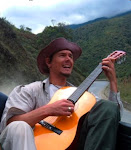so……where was i?
on my way back to mindo if I recall correctly……almost a month ago…….
Fun to come back after a month away……during which time the identification of many of my photos facilitated the feeling of familiarity and home-coming, amazing really the way that learning the plants can connect one to the landscape……the whole point in a certain way…..and certainly an inspiration to work on this guide……
And more to see!!!!
My first day back I added half a dozen orchid species to my growing list……
A little, yellow, former-liliy, Hypoxis decumbens now in the Hypoxidaceae
Citrus in flower
Furcraea, which I had originally misidentified as agave, in bloom
Large shrubs of Sauraria, in a family that was new to me, the Actinidaceae….
I felt as though my base of knowledge allowed attention to be paid to the more subtle community members, now that I had figured out many of the more conspicuous ones……
Of course there were big, flashy flowers that called my gaze that simply had not been in bloom the last time I was there, such as the humming-bird pollinated Centropogon solanifolium….which was fun too…..
a number of large sobralia orchids….allowing the opportunity to sample and compare the sweet perfumey fragrances….
Also got to walk with a couple of different guides……wow! What a luxury to have someone just tell me what things were!!!!
Nice though too that I had waited and struggled through much of the id on my own……this meant that after a full day of hiking with the proprietor of one of the larger orchid gardens in the area, it really felt like a botanical exchange…..i certainly learned a lot, but he too had gotten something out of the excursion and was happy with the trade…….and although I offered to pay him for his time, I was secretly grateful when he refused the offer!
Everyone that I talked to was excited about the idea of the guide I am working on…so that was encouraging……
After a week in the field, I headed back to quito to finish up at the herbarium, identifying some of my new finds and confirming some of my older ones……
After running into a bit of a glitch changing my plane ticket, I ended up spending almost 3 weeks in quito!!!
Not the rich biological experience of the campo……but worthwhile for the work I was able to do at the herbarium, and the cultural element of that much interaction in spanish! And thanks to friends, I had a place to stay………
With almost 200,000 specimens, the herbario nacional del Ecuador, was certainly the largest collection that I had done any work in…….
Interesting to uncover the history of it all through the process of trying to identify my own plants….collections and determinations made by Al Gentry the author of the Field Guide to Woody Plants of NW South America…..who died tragically when the plane that was carrying him to do a rapid biological assessment crashed into a mountain side in western Ecuador some 15 years ago…..
They say that his spirit actually visits the herbarium to this day….and if you are there alone at night, it is not uncommon to hear folders of dried plants being rifled though!
For more info: http://www.fieldmuseum.org/research_collections/ecp/ecp_sites/Parker_Gentry/gentry.htm
Collections by Caloway Dodson and David Neill, the founders of the herbarium (both out of the Missouri botanical garden),
collections by Brian Boom from the new york botanical garden in the 1980s that were funded by the National Cancer Institute…….
wonder what they found out…..interesting that they were interested in Rubus’……
The 13,418th collection made by Jim Luteyn – ericaceae expert form NY Botanical Garden was not an ericaceae at all, but a Rubus megalococcus…….
For more info: http://www.nybg.org/bsci/res/lut2/
Phytochemist Edward Kennelly collected a Commelina with no known use, as part of a ethnobotanical survey…….i got a chance to speak with him about this and other plants when we met in his office at CUNY in the Bronx last week!
One day I had the chance to chat with Charlotte Taylor, the world expert on the rubiaceae, (also from Missouri botanical garden) who took one look at a photo that had stumped me for over a month, and in a moment, she not only told me what it was, but gave me a whole lost of diagnostic characters!!!!
For more info: http://www.mobot.org/mobot/research/
I got a quote on printing this guide (the family I was staying with runs a print shop!)………
but of course the more you print the cheaper it is……….
the plan now is to try and find someone who wants to donate some money to print 500 copies……..
but in the worst case scenario……the director of the herbarium, David Neill said that they could likely print smaller batches there!!!!
Cities really are about connecting with people……
Well, back in America del norte……
My first glimpse was Atlanta at sunrise,
more beautiful from the air than from inside the airport surrounded by homeland security and CNN……..pharmecueticals in the water supply, legislators claiming that “homosexuals are more dangerous than terrorists”…..
it has been a week now…..getting used to the grey of the deciduous eastern woods in winter, so different than the verdant greenery I left behind……
the only thing blooming skunk cabbage and hazelnuts……and not the skunk cabbage that I know from the west coast……this version a mottled purple, and bearing the name Symplocarpus foetidus……not Lysichiton americanum…….a good reminder that common names can be tricky what-ever the language ……..
looking forward again to the green of Oregon…..
thanks for listening throughout these months and giving me an inspiration to record my thoughts and experiences…….
Many of you I will get a chance to see quite soon,
And to those of you that I will not see, I wish you a happy spring!!!
En solidaridad y paz,
Tobias
Suscribirse a:
Enviar comentarios (Atom)





No hay comentarios:
Publicar un comentario